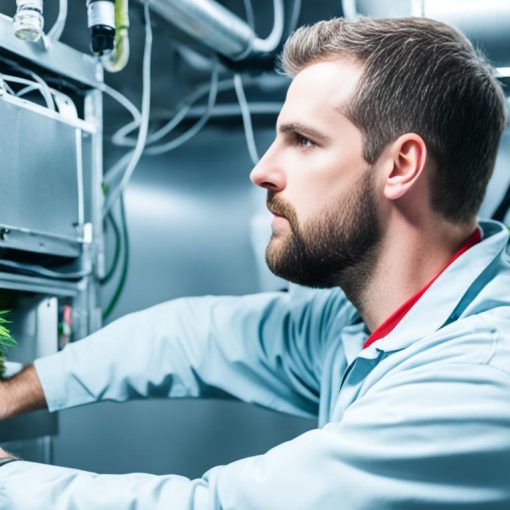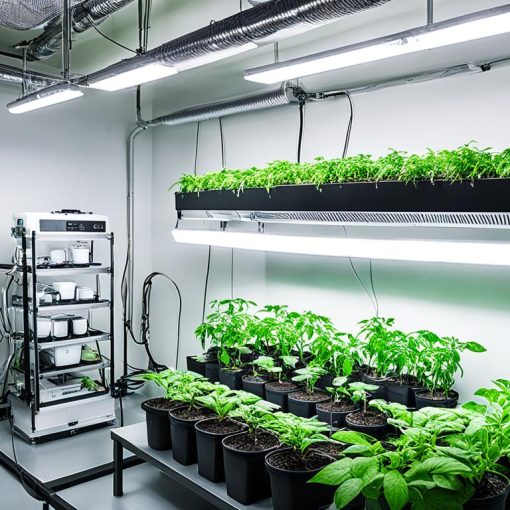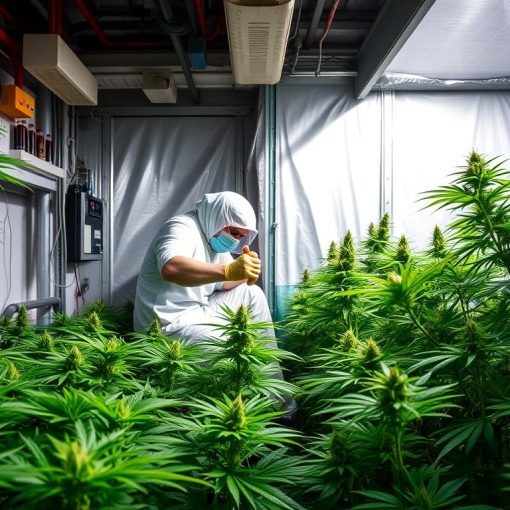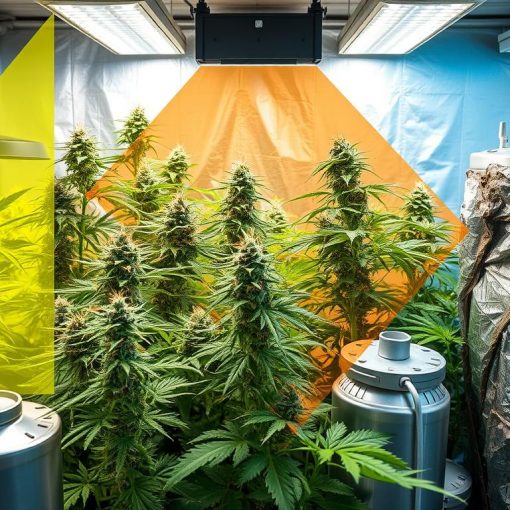Achieving ideal growing conditions is crucial for optimal cannabis yields. Effective climate control plays a vital role in cannabis cultivation, ensuring a healthy and thriving crop.
By maintaining precise temperature and humidity levels, growers can prevent common issues such as mold and pests. For more information on optimizing growing conditions, resources are available at www.tricleanair.com and through various YouTube tutorials on cannabis engineering.
Key Takeaways
- Maintain precise temperature and humidity levels.
- Prevent mold and pests through effective climate control.
- Optimize growing conditions for healthier crops.
- Utilize resources from www.tricleanair.com.
- Explore YouTube tutorials on cannabis engineering.
The Critical Role of Climate Control in Cannabis Cultivation
Effective cannabis climate control is the backbone of successful cannabis cultivation. By maintaining optimal environmental conditions, growers can significantly enhance the health, potency, and yield of their cannabis crops.
Why Environmental Factors Make or Break Your Harvest
Environmental factors such as temperature, humidity, and airflow play a crucial role in the development of cannabis plants. Temperature fluctuations can stress plants, leading to reduced growth and potency. Similarly, high humidity levels can foster the growth of mold and mildew, devastating entire crops.
By understanding and controlling these environmental factors, growers can prevent common issues and ensure a healthy harvest.
The Science Behind Plant Response to Climate Conditions
Cannabis plants respond to their climate conditions through complex physiological processes. For instance, plants adjust their growth rate and development based on temperature and light exposure. CO2 supplementation can further enhance growth by providing more carbon dioxide for photosynthesis.
How Climate Control Affects Potency and Yield
Climate control directly impacts the potency and yield of cannabis. Optimal temperature and humidity levels can maximize THC production and bud density. Moreover, a well-controlled climate helps in preventing stressors that can reduce potency and yield.
By investing in a robust cannabis climate control system, growers can significantly improve their crop’s quality and quantity.
Understanding Cannabis Climate Control Systems
To achieve ideal growing conditions, cannabis engineers rely on sophisticated climate control systems. These systems are designed to mimic the natural environment that cannabis plants thrive in, ensuring optimal growth and potency.
Components of an Effective Climate Control Setup
An effective climate control setup for cannabis cultivation involves several key components. These include temperature control units, humidity management systems, and advanced air circulation mechanisms. Temperature control is critical, as cannabis plants are sensitive to temperature fluctuations. A reliable climate control system ensures that the grow room maintains a consistent temperature, day and night.
TriCleanAir Solutions for Cannabis Cultivation
TriCleanAir solutions offer advanced technology for cannabis cultivation, providing clean air and optimal climate conditions. Their systems are designed to remove contaminants and maintain a healthy environment for cannabis plants. By incorporating TriCleanAir solutions, growers can significantly improve the quality and yield of their crops.
“The quality of the air directly impacts the health and productivity of cannabis plants. Advanced air purification systems are essential for maintaining a clean and optimal growing environment.” – Expert in Cannabis Cultivation
Automated vs. Manual Control Systems
When it comes to climate control systems, growers have the option of automated or manual control. Automated systems offer real-time monitoring and adjustments, ensuring that the grow environment remains optimal. Manual control systems, on the other hand, require more labor and can be prone to human error. For large-scale cannabis engineering projects, automated systems are generally preferred for their precision and efficiency.
| Feature | Automated Systems | Manual Systems |
|---|---|---|
| Precision | High | Variable |
| Labor Required | Low | High |
| Scalability | Easy | Challenging |
Scaling Your System: From Home Grows to Commercial Operations
As cannabis cultivation operations grow from small home grows to large commercial enterprises, their climate control systems must scale accordingly. This involves upgrading equipment and potentially adopting more sophisticated climate control systems. By investing in scalable climate control systems, cannabis engineers can ensure that their operations remain efficient and productive.
Understanding and implementing effective climate control systems is crucial for successful cannabis cultivation. By leveraging advanced technologies and scalable solutions, growers can optimize their yields and improve the quality of their cannabis products.
Temperature Management for Cannabis Plants
Cannabis plants require precise temperature conditions to thrive, making temperature management a critical aspect of cannabis climate control. Effective temperature regulation ensures healthy growth, maximizes yield, and enhances the overall quality of the cannabis.
Optimal Temperature Ranges for Different Growth Stages
Different stages of cannabis growth have distinct temperature requirements. During the vegetative stage, temperatures between 65°F to 75°F (18°C to 24°C) promote healthy leaf development. In the flowering stage, slightly lower temperatures, ranging from 60°F to 70°F (15°C to 21°C), can improve bud formation and density.
Day vs. Night Temperature Differentials
Cannabis plants benefit from a natural day-night temperature differential. A 5°F to 10°F (3°C to 6°C) drop in temperature at night can help simulate natural outdoor conditions, promoting healthier plant development and potentially increasing yields.
Heating and Cooling Equipment Options
To maintain optimal temperatures, cannabis cultivators can employ various heating and cooling solutions. For larger operations, HVAC systems are often the most effective choice, providing both heating and cooling capabilities. For smaller grows, more economical options like supplemental heating solutions (e.g., space heaters) or evaporative cooling systems can be sufficient.
HVAC Systems for Cannabis Facilities
HVAC systems offer a comprehensive solution for temperature management in cannabis facilities. They can be designed to handle the specific cooling needs of grow rooms, which often generate significant heat due to lighting and other equipment.
Supplemental Heating Solutions
For periods of cold weather, supplemental heating solutions can help maintain the desired temperature range. These can be particularly useful in unheated grow spaces or during unexpected cold snaps.
Seasonal Temperature Adjustments
As outdoor temperatures change with the seasons, indoor cannabis cultivation facilities may need to adjust their temperature management strategies. This can involve modifying HVAC settings or employing additional heating or cooling measures to maintain optimal conditions year-round.
By carefully managing temperature conditions, cannabis cultivators can significantly improve crop health, yield, and quality. Whether through advanced HVAC systems or simple adjustments to heating and cooling, maintaining the right temperature is crucial for successful cannabis cultivation.
Humidity Control: The Key to Preventing Mold and Maximizing Growth
The importance of humidity control in cannabis cultivation cannot be overstated, as it prevents mold and maximizes growth. Humidity control is a critical aspect of cannabis engineering, directly influencing plant health, yield, and overall quality.
Vapor Pressure Deficit (VPD) Explained
Vapor Pressure Deficit (VPD) is a crucial concept in understanding humidity control. It represents the difference between the amount of moisture in the air and the amount of moisture that the air can hold. A proper VPD is essential for optimal plant transpiration and nutrient uptake.
VPD is influenced by both temperature and humidity. By managing VPD, growers can create an environment that promotes healthy plant growth and prevents water stress.
Ideal Humidity Levels Throughout the Growth Cycle
Different stages of cannabis growth require specific humidity levels. Generally, higher humidity is recommended during the vegetative stage, while lower humidity is preferred during the flowering stage.
- Vegetative stage: 40-60% relative humidity
- Flowering stage: 30-50% relative humidity
- Clone/rooting stage: 60-80% relative humidity
Dehumidification and Humidification Equipment
To maintain ideal humidity levels, growers use dehumidification and humidification equipment. The choice between these depends on the specific needs of the grow space.
Commercial Dehumidifiers for Cannabis Cultivation
Commercial dehumidifiers are designed to handle large grow spaces. They are effective in removing excess moisture from the air, preventing mold and mildew.
| Dehumidifier Type | Capacity | Energy Efficiency |
|---|---|---|
| Refrigerant Dehumidifiers | High | Moderate |
| Desiccant Dehumidifiers | Moderate | High |
Humidification Options for Dry Environments
In dry environments, humidification is necessary to maintain optimal humidity levels. Options include ultrasonic humidifiers and evaporative humidifiers.
Preventing Mold and Mildew Through Proper Humidity Management
Proper humidity management is key to preventing mold and mildew. By maintaining optimal humidity levels and ensuring good air circulation, growers can significantly reduce the risk of these pathogens.
Regular monitoring and adjustments are necessary to maintain the ideal humidity levels throughout the growth cycle.
Mastering Airflow and Ventilation
Effective airflow and ventilation are crucial for maintaining ideal cannabis climate control. Proper air circulation helps prevent the buildup of heat, humidity, and CO2, creating a healthy environment for cannabis plants to thrive.
Creating Proper Air Circulation Patterns
To achieve optimal air circulation, growers should consider the layout of their grow space. Strategic fan placement can help create a uniform air circulation pattern, reducing stagnant areas where heat and moisture can accumulate.
- Use oscillating fans to circulate air throughout the grow space.
- Position fans to create a gentle breeze that promotes healthy plant growth.
- Avoid directing fans straight onto plants to prevent stress.
Ventilation Requirements for Different Grow Spaces
Ventilation needs vary depending on the size and type of grow space. Commercial operations, for instance, require more complex ventilation systems compared to small home grows.
- Calculate ventilation needs based on the volume of the grow space.
- Consider factors like heat output from lighting and equipment.
- Ensure adequate ventilation to remove stale air and bring in fresh air.
Fan Types and Placement Strategies
Different types of fans serve various purposes in maintaining airflow. In-line fans are often used for exhaust purposes, while oscillating fans help with air circulation.
Air Filtration and Odor Control Solutions
Air filtration is critical for controlling odors and preventing the spread of pests and diseases. Carbon filters are commonly used for odor control.
Carbon Filters and Scrubbers
Carbon filters absorb odors and volatile organic compounds (VOCs), improving air quality.
HEPA Filtration for Pest and Pathogen Control
HEPA filters capture 99.97% of particles as small as 0.3 microns, including many pests and pathogens.
By mastering airflow and ventilation, cannabis cultivators can create an optimal growing environment that promotes healthy plant growth and maximizes yields.
CO2 Enrichment Techniques and Equipment
To maximize cannabis yields, growers are turning to CO2 enrichment techniques. CO2 supplementation is a critical component of cannabis engineering, enhancing plant growth and overall yield.
Benefits of CO2 Supplementation
CO2 enrichment benefits cannabis plants by enhancing photosynthesis, leading to faster growth rates and higher yields. Studies have shown that optimal CO2 levels can increase plant density and potency.
- Enhanced photosynthesis
- Faster growth rates
- Increased yields
- Improved plant density and potency
Safe CO2 Levels and Monitoring Systems
Maintaining safe CO2 levels is crucial. The ideal CO2 concentration for cannabis cultivation typically ranges between 1,000 to 1,500 ppm. Monitoring systems are essential to ensure these levels are maintained without exceeding safe limits for both plants and humans.
CO2 Generation Methods
There are several methods for CO2 generation, each with its advantages.
Tank-Based Systems
Tank-based systems store CO2 in tanks, releasing it as needed. These systems are reliable but require regular tank replacements.
CO2 Generators
CO2 generators produce CO2 through combustion or other processes. They offer a more continuous supply but may require additional ventilation.
Balancing CO2 with Other Environmental Factors
Effective cannabis engineering involves balancing CO2 levels with other environmental factors such as temperature, humidity, and light. This balance is crucial for maximizing the benefits of CO2 enrichment.
By understanding and implementing CO2 enrichment techniques, cannabis growers can significantly improve their crop yields and quality.
Energy Efficiency in Cannabis Climate Control
Energy efficiency in cannabis climate control is not just about reducing costs; it’s also about creating a sustainable cultivation process. As cannabis growers strive to optimize their operations, they must consider various strategies to minimize energy consumption while maintaining ideal conditions for their plants.
Reducing Energy Consumption While Maintaining Ideal Conditions
One of the primary ways to achieve energy efficiency is by optimizing the climate control system. This involves using advanced technologies that can monitor and adjust environmental conditions in real-time, ensuring that energy is not wasted on unnecessary heating, cooling, or humidification.
LED Lighting and Heat Management
LED lighting has become a staple in cannabis cultivation due to its energy efficiency and ability to produce specific light spectra that promote plant growth. However, LEDs still emit heat, which must be managed effectively to prevent overheating and reduce the load on cooling systems. Proper LED placement and heat sinks can significantly improve energy efficiency.
Insulation and Building Envelope Considerations
The building envelope plays a critical role in maintaining energy efficiency. Proper insulation can prevent heat loss in the winter and heat gain in the summer, reducing the need for excessive heating and cooling. Sealing any gaps or leaks in the grow facility is also crucial to maintaining a consistent internal environment.
Sustainable Climate Control Practices
Sustainable practices are becoming increasingly important in cannabis cultivation. This includes not only energy-efficient equipment but also broader strategies like water reclamation and renewable energy integration.
Water Reclamation Systems
Water reclamation systems can significantly reduce water waste by recycling water from various sources within the cultivation facility. This not only conserves water but also reduces the energy needed to treat and pump water.
Renewable Energy Integration
Integrating renewable energy sources, such as solar or wind power, can drastically reduce a cultivation operation’s carbon footprint. By generating their own energy, growers can reduce their reliance on grid power and lower their energy costs.
By implementing these strategies, cannabis cultivators can achieve a more sustainable and energy-efficient operation, ultimately benefiting both their bottom line and the environment.
Troubleshooting Common Climate Control Issues
Troubleshooting climate control issues is a vital aspect of cannabis engineering that ensures optimal growing conditions. Climate control problems can lead to reduced yields, lower potency, and increased risk of mold and mildew. By identifying and resolving these issues promptly, growers can protect their crops and maximize their harvest.
Identifying Environmental Stress Symptoms in Cannabis Plants
Cannabis plants exhibit specific symptoms when exposed to environmental stressors. These can include yellowing leaves, slow growth, or increased susceptibility to pests. By recognizing these symptoms early, growers can take corrective action to adjust temperature, humidity, or airflow.
Resolving Temperature Fluctuations
Temperature fluctuations can significantly impact cannabis growth. To resolve these issues, growers should first check their heating and cooling systems to ensure they are functioning correctly. Regular maintenance, such as cleaning filters and checking thermostat calibration, is crucial.
Addressing Humidity-Related Problems
Humidity control is critical in cannabis cultivation. Too high humidity can lead to mold and mildew, while too low can cause water stress. Using dehumidifiers and humidifiers appropriately can help maintain the ideal relative humidity levels throughout the growth cycle.
Airflow Optimization Challenges
Proper airflow is essential for healthy cannabis plants. It helps prevent the buildup of CO2 and maintains even temperatures. Optimizing airflow involves strategically placing fans and ensuring that air circulation patterns are not obstructed.
Calibrating and Maintaining Monitoring Equipment
Accurate monitoring is key to effective climate control. Regular calibration and maintenance of monitoring equipment ensure that temperature, humidity, and CO2 levels are accurately measured. This allows growers to make informed decisions and adjust their climate control strategies as needed.
By following these troubleshooting guidelines, cannabis growers can address common climate control issues, ensuring a healthy and productive crop. Effective climate control is a cornerstone of successful cannabis cultivation.
Conclusion: Creating Your Ideal Cannabis Growing Environment
Achieving an ideal growing environment is crucial for cannabis cultivation. By implementing effective cannabis climate control measures, growers can significantly enhance the quality and yield of their crops. Temperature, humidity, airflow, and CO2 levels all play critical roles in creating an optimal environment.
By understanding and managing these factors, cultivators can prevent common issues such as mold, mildew, and environmental stress. This involves selecting the right equipment, such as heating and cooling systems, dehumidifiers, and ventilation fans, and ensuring proper maintenance and calibration.
By investing in a well-designed cannabis climate control system, growers can create an ideal growing environment that fosters healthy plant growth and maximizes yields. This not only improves the overall quality of the cannabis but also increases the profitability of the cultivation operation.




